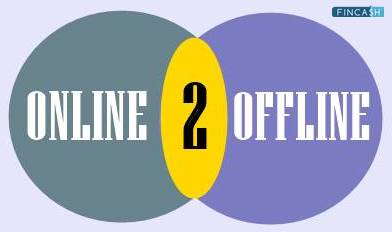Online-To-Offline Commerce (O2O) Meaning
Online-to-offline (O2O) commerce refers to a business approach that attracts potential customers to make purchases in physical stores via online channels.

Customers are identified in the online environment, including through emails and web advertising, and are then enticed to leave the online space using several techniques and approaches. This method combines online marketing strategies with offline marketing techniques.
Working Offline-to-Online Retail in an O2O Platform
Online shops can offer a large assortment without paying for as many workers, and all they need to sell their goods is access to delivery companies. Owing to this, retailers were worried that they wouldn't be able to compete with online-only businesses, particularly in terms of price and selection.
Physical stores had significant fixed costs (rent) and numerous staff to manage them, and they couldn't provide as vast a selection of goods due to space constraints. Some businesses with online and offline presence regard the two channels as complementary rather than competitive.
The purpose of online-to-offline commerce is to raise product and service awareness online, allowing potential buyers to explore various offers before purchasing a local brick-and-mortar business.
Here are all the techniques that O2O platform commerce companies use:
- In-store pickup of things bought online
- Allowing the return Facility of items purchased online in a physical store
- Enabling customers to place orders online while staying in a physical store
Key O2O Benefits
Some of the major O2O benefits have been listed below:
- Give customers exactly what they want
- Increase your customer base
- Sales and brand recognition
- Spend less on logistics
Talk to our investment specialist
Exceptions of Online to Offline Marketing
The development of online-to-offline commerce does not rule out the possibility of making purchases online. Customers will do their research online and go to a store to view the goods physically - they may want to try them on or compare prices. After that, the customer can still purchase the item online. Ecommerce enterprises, and the online application frameworks that support them, are still going strong. They haven't been wiped out by cross-border commerce.
Offline to Online Business Examples
There are several O2O business examples, as follows:
- Amazon purchased Whole Foods
- The $3 billion acquisition of Jet.com by traditional retailer Walmart in 2016
- Customers can order and pay via Starbucks' Mobile Order and Pay via their phones
- Glossier uses Instagram to direct customers to its actual locations
- Ecommerce retailer Bonobos has launched the Guide Shop
O2O Business Model in India
In India, the lockdown has improved the reputation of local businesses, particularly Kirana or Grocery stores. Previously, the government and newspapers criticised the mixed-use model and compared it to European and American streets. Now, to the point, there are no long lines outside supermarkets or hypermarts because of these tiny shops, and there is less reliance on big retailers. Indians relied on little grocery stores during the lockdown to meet their needs.
DMart, BigBazaar, and other major retailers have closed or reduced their stock. Due to many pending orders, online grocery merchants such as Bigbasket, Grofers, and Amazon local were unable to process them.
Conclusion
Customers are enticed from the internet space to physical stores through O2O commerce, using marketing and advertising strategies. In addition, technology, such as mobile apps and in-store retail kiosks, is being implemented.
You can construct an O2O business by incorporating as many of these approaches and technology into your company and combining online and offline strategies. Retailers have many options for combining online and offline commerce into a positive shopping experience that keeps customers happy and enhances revenues. Furthermore, if Amazon and Alibaba see O2O commerce as the next phase in their eCommerce evolution, you can be assured that it will benefit your company's growth.
All efforts have been made to ensure the information provided here is accurate. However, no guarantees are made regarding correctness of data. Please verify with scheme information document before making any investment.












